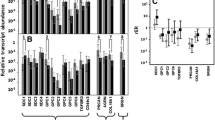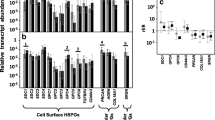Abstract—Glypican-3 (GPC3), a heparan sulfate proteoglycan is an emerging tumor marker; its overexpression has been stated in several types of cancer such as hepatocellular carcinoma (HCC), melanoma and etc. In this study, the expression of the GPC3 mRNA was investigated in 61 human colorectal cancer (CRC) tissues and 61 normal adjacent tissues, using the real-time PCR assay. Using immunohistochemistry (IHC), the expression of the GPC3 protein was examined in the cases that showed a marked elevation in the expression of the GPC3 mRNA in the tumor tissues, compared to the normal tissues. A significant increase in the expression of the GPC3 gene was revealed in 49.2% of the cases of CRC tumors, compared to the normal adjacent tissues. The expression of the GPC3 mRNA was found to significantly correlate with the pathological differentiation and the age of the patients. Interestingly, a significant reduction in the expression of the GPC3 mRNA was found in the tumor tissues of the 16 patients, who underwent the neoadjuvant chemotherapy, compared to the normal adjacent tissues. Unexpectedly, the GPC3 protein was not detected by IHC in 30 tissues, exhibiting the upregulation in the expression of the GPC3 mRNA. Our results indicated that GPC3 could be expressed in the CRC tissues at the mRNA level, while its expression could not be found at the protein level.





Similar content being viewed by others
REFERENCES
Gervaz, P., Bouzourene, H., Cerottini, J.P., Chaubert, P., Benhattar, J., Secic, M., Wexner, S., Givel, J.C., and Belin, B., and Dukes, B., Colorectal cancer: distinct genetic categories and clinical outcome based on proximal or distal tumor location, Dis. Colon Rectum., 2001, vol. 44, no. 3, pp. 364–372.
Terzic, J., Grivennikov, S., Karin, E., and Karin, M., Inflammation and colon cancer, Gastroenterology, 2010, vol. 138, no. 6, pp. 2101–2114. e5. https://doi.org/10.1053/j.gastro.2010.01.058
Abdifard, E., Amini, S., Bab, S., Masroor, N., Khachian, A., and Heidari, M., Incidence trends of colorectal cancer in Iran during 2000–2009: a population-based study, Med. J. Islam. Repub. Iran, 2016, vol. 30, p. 382.
Center, M.M., Jemal, A., and Ward, E., International trends in colorectal cancer incidence rates, Cancer Epid. Prevent. Biomark., 2009, vol. 18, no. 6, pp. 1688–1694.
Siegel, R.L., Miller, K.D., Fedewa, S.A., Ahnen, D.J., Meester, R.G.S., Barzi, A., and Jemal, A., Colorectal cancer statistics. 2017, CA Cancer J. Clin., 2017, vol. 67, no. 3, pp. 177–93. https://doi.org/10.3322/caac.21395
De Cat, B. and David, G., Developmental roles of the glypicans, Semin. Cell Dev. Biol., 2001, vol. 12, no. 2, pp. 117–125.https://doi.org/10.1006/scdb.2000.0240
Wang, X.Y., Degos, F., Dubois, S., Tessiore, S., Allegretta, M., Guttmann, R.D., Jothy, S., Belghiti, J., Bedossa, P., and Paradis, V., Glypican-3 expression in hepatocellular tumors: diagnostic value for preneoplastic lesions and hepatocellular carcinomas, Hum. Pathol., 2006, vol. 37, no. 11, pp. 1435–1441. https://doi.org/10.1016/j.humpath.2006.05.016
Traister, A., Shi, W., and Filmus, J., Mammalian Notum induces the release of glypicans and other GPI-anchored proteins from the cell surface, Biochem. J., 2008, vol. 410, no. 3, pp. 503–511.
Ho, M. and Kim, H., Glypican-3: a new target for cancer immunotherapy, Eur. J. Cancer, 2011, vol. 47, no. 3, p. 333–338. https://doi.org/10.1016/j.ejca.2010.10.024
Pilia, G., Hughes-Benzi,e, R.M., MacKenzie, A., Baybayan, P., Chen, E.Y., Huber, R., Neri, G., Cao, A., Forabosco, A., and Schlessinger, D., Mutations in GPC3, a glypican gene, cause the Simpson–Golabi–Behmel overgrowth syndrome, Nat. Genet., 1996, vol. 12, no. 3, pp. 241–247. https://doi.org/10.1038/ng0396-241
Yun-Yan, X., Ladeda, V., and Filmus, J., Glypican-3 expression is silenced in human breast cancer, Oncogene, 2001, vol. 20, no. 50, pp. 7408–7412. https://doi.org/10.1038/sj.onc.1204925
Capurro, M.I., Xu, P., Shi, W., Li, F., Jia, A., and Filmus, J., Glypican-3 inhibits Hedgehog signaling during development by competing with patched for Hedgehog binding, Dev. Cell, 2008, vol. 14, no. 5, pp. 700–711. https://doi.org/10.1016/j.devcel.2008.03.006
Capurro, M.I., Xiang, Y.Y., Lobe, C., and Filmus, J., Glypican-3 promotes the growth of hepatocellular carcinoma by stimulating canonical Wnt signaling, Cancer Res., 2005, vol. 65, no. 14, pp. 6245–6254. https://doi.org/10.1158/0008-5472.CAN-04-4244
Feng, M. and Ho, M., Glypican-3 antibodies: a new therapeutic target for liver cancer, FEBS Lett., 2014, vol. 588, no. 2, pp. 377–82. https://doi.org/10.1016/j.febslet.2013.10.002
Song, H.H., Shi, W., Xiang, Y.Y., and Filmus, J., The loss of glypican-3 induces alterations in Wnt signaling, J. Biol. Chem., 2005, vol. 280, no. 3, pp. 2116–2125. https://doi.org/10.1074/jbc.M410090200
Dwivedi, P., Lam, N., and Powell, B.C., Boning up on glypicans—opportunities for new insights into bone biology, Cell Biochem. Func., 2013, vol. 31, no. 2, pp. 91–114. https://doi.org/10.1002/cbf.2939
Capurro, M., Martin, T., Shi, W., and Filmus, J., Glypican-3 binds to Frizzled and plays a direct role in the stimulation of canonical Wnt signaling, J. Cell Sci., 2014, vol. 127, no. 7, pp. 1565–1575. https://doi.org/10.1242/jcs.140871
Sun, C.K., Chua, M.S., He, J., and So, S.K., Suppression of glypican 3 inhibits growth of hepatocellular carcinoma cells through up-regulation of TGF-2, Neoplasia, 2011, vol. 13, no. 8, pp. 735–747. https://doi.org/10.1593/neo.11664
Yamanaka, K., Ito, Y., Okuyama, N., Noda, K., Matsumoto, H., Yoshida, H., Miyauchi, A., Capurro, M., Filmus, J., and Miyoshi, E., Immunohistochemical study of glypican 3 in thyroid cancer, Oncology, 2007, vol. 73, nos. 5/6, pp. 389–94. https://doi.org/10.1159/000136159
Shirakawa, H., Kuronuma, T., Nishimura, Y., Hasebe, T., Nakano, M., Gotohda, N., Takahashi, S., Nakagohri, T., Konishi, M., Kobayashi, N., Kinoshita, T., and Nakatsura, T., Glypican-3 is a useful diagnostic marker for a component of hepatocellular carcinoma in human liver cancer, Int. J. Oncol., 2009, vol. 34, no. 3, pp. 649–656. https://doi.org/10.3892/ijo_00000190
Nakatsura, T., Kageshita, T., Ito, S., Wakamatsu, K., Monji, M., Ikuta, Y., Senju, S., Ono, T., and Nishimura, Y., Identification of glypican-3 as a novel tumor marker for melanoma, Clin. Cancer Res., 2004, vol. 10, no. 19, p. 6612–6621. https://doi.org/10.1158/1078-0432.CCR-04-0348
Maeda, D., Ota, S., Takazawa, Y., Aburatani, H., Nakagawa, S., Yano, T., Taketani, Y., Kodama, T., and Fukayama, M., Glypican-3 expression in clear cell adenocarcinoma of the ovary, Mod. Pathol., 2009, vol. 22, no. 6, pp. 824–832. https://doi.org/10.1038/modpathol.2009.40
FFu, S.J., Qi, C.Y., Xiao, W.K., Li, S.Q., Peng, B.G., and Liang, L.J., Glypican-3 is a potential prognostic biomarker for hepatocellular carcinoma after curative resection, Surgery, 2013, vol. 154, no. 3, pp. 536–544. https://doi.org/10.1016/j.surg.2013.02.014
van Diest, P.J., van Dam, P., Henzen-Logmans, S.C., Berns, E., van der Burg, M.E., Green, J., and Vergote, I., A scoring system for immunohistochemical staining: consensus report of the task force for basic research of the EORTC-GCCG. European Organization for Research and Treatment of Cancer-Gynaecological Cancer Cooperative Group, J. Clin. Pathol., 1997, vol. 50, no. 10, pp. 801–804. https://doi.org/10.1136/jcp.50.10.801
Umezu, T., Shibata, K., Kajiyama, H., Yamamoto, E., Nawa, A., and Kikkawa, F., Glypican-3 expression predicts poor clinical outcome of patients with early-stage clear cell carcinoma of the ovary, J. Clin. Pathol., 2010, vol. 63, no. 11, pp. 962–966. https://doi.org/10.1136/jcp.2010.080234
Kendrick, N., A Gene’s mRNA Level Does Not Usually Predict Its Protein Level, Madison: Kendricklabscom, 2014.
Schwanhausser, B., Busse, D., Li, N., Dittmar, G., Schuchhardt, J., Wolf, J., Chen, W., and Selbach, M., Global quantification of mammalian gene expression control, Nature, 2011, vol. 473, pp. 337–342.
Vogel, C., Abreu, Rde.S., Ko, D., Le, S.Y., Shapiro, B.A., Burns, S.C., Sandhu, D., Boutz, D.R., Marcotte, E.M., and Penalva, L.O., Sequence signatures and mRNA concentration can explain two-thirds of protein abundance variation in a human cell line, Mol. Syst. Biol., 2010, vol. 6, no. 1, p. 400. https://doi.org/10.1038/msb.2010.59
Asangani, I.A., Rasheed, S.A., Nikolova, D.A., Leupold, J.H., Colburn, N.H., Post, S., and Allgayer, H., microRNA-21 (miR-21) post-transcriptionally downregulates tumor suppressor Pdcd4 and stimulates invasion, intravasation and metastasis in colorectal cancer, Oncogene, 2008, vol. 27, no. 15, pp. 2128–2136. https://doi.org/10.1038/sj.onc.1210856
Slaby, O., Svoboda, M., Michalek, J., and Vyzula, R., microRNAs in colorectal cancer: translation of molecular biology into clinical application, Mol. Cancer, 2009, vol. 8, no. 1, p. 102. https://doi.org/10.1186/1476-4598-8-102
Miao, H.L., Lei, C.J., Qiu, Z.D., Liu, Z.K., Li, R., Bao, S.T., and Li, M.Y., microRNA-520c-3p inhibits hepatocellular carcinoma cell proliferation and invasion through induction of cell apoptosis by targeting glypican-3, Hepatol. Res., 2014, vol. 44, no. 3, pp. 338–348. https://doi.org/10.1111/hepr.12121
Hay, E.D., Cell Biology of Extracellular Matrix, Springer Science and Business Media, 2013.
Joypaul, B.V., Newman, E.L., Hopwood, D., Grant, A., Qureshi, S., Lane, D.P., and Cuschieri, A., Expression of p53 protein in normal, dysplastic, and malignant gastric mucosa: an immunohistochemical study, J. Pathol., 1993, vol. 170, no. 3, pp. 279–283. https://doi.org/10.1002/path.1711700310
Yoneda, A., Lendorf, M.E., Couchman, J.R., and Multhaupt, H.A., Breast and ovarian cancers: a survey and possible roles for the cell surface heparan sulfate proteoglycans, J. Histochem. Cytochem., 2012, vol. 60, no. 1, pp. 9–21. https://doi.org/10.1369/0022155411428469
Araki, K. and Nagata, K., Protein folding and quality control in the ER, Cold Spring Harb. Perspect. Biol., 2011, vol. 3, no. 11, p. a007526. https://doi.org/10.1101/cshperspect.a007526
Montalbano, M., Georgiadis, J., Masterson, A.L., McGuire, J.T., Prajapati, J., Shirafkan, A., Rastellini, C., and Cicalese, L., Biology and function of glypican-3 as a candidate for early cancerous transformation of hepatocytes in hepatocellular carcinoma, Oncology Rep., 2017, vol. 37, no. 3, pp. 1291–1300. https://doi.org/10.3892/or.2017.5387
Haggar, F.A. and Boushey, R.P., Colorectal cancer epidemiology: incidence, mortality, survival, and risk factors, Clin. Colon Rect. Surg., 2009, vol. 22, no. 4, pp. 191–197. https://doi.org/10.1055/s-0029-1242458
Author information
Authors and Affiliations
Corresponding authors
Ethics declarations
Conflict of interests. The authors declare that they have no conflict of interest.
Statement of compliance with standards of research involving humans as subjects. All procedures performed in studies involving human participants were in accordance with the ethical standards of the institutional and/or national research committee and with the 1964 Helsinki Declaration and its later amendments or comparable ethical standards. Written informed consent was obtained from all the subjects prior to surgery.
About this article
Cite this article
Azizpour, S., Ezati, R., Saidijam, M. et al. The Expression of Glypican-3 in Colorectal Cancer. Cytol. Genet. 53, 430–440 (2019). https://doi.org/10.3103/S0095452719050037
Received:
Revised:
Accepted:
Published:
Issue Date:
DOI: https://doi.org/10.3103/S0095452719050037




